Several past postings have been about appliques of various forms that are meant for adding on to other surfaces, usually to clothing. While I normally sew mine on, there are a wider number of ones on the market that are meant to be ironed on. Here are some of the ones that I’ve purchased.
Butterflies are some of my favorite creatures and I use a lot of them in my work, since many of my beaded art quilts have garden themes. This Monarch butterfly applique is readily available in many craft stores. While they have glue on the back,meant to stick when heat is applied, I don’t trust them to stick permanently/ I always sew them on, even though the glue makes them quite stiff and hard to pierce with a sewing needle. For this butterfly, I used black leaf beads with white veins for the body of the insect and the tips of the upper wings. Shiny, square golden orange beads accent the sections of the wings, while a small gold button with a crystal center serves as the head.
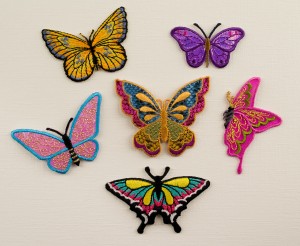 Here are a number of other iron-on butterflies awaiting a home on some future art quilt. They range in sizes with the largest center one being about 3″ or 7.5 cm tall. They vary in the amount of detail that is shown, and the trick is to be careful not to use too many buttons and beads, no matter how small, so that some of the original colors and markings still show through. Fortunately, you can get a wide range of colors on-line for just about any color scheme, realistic images or not, that you might want to create. One difficulty in embellishing these lovelies, besides the difficulty of beading thorough the stiff material, is not covering up the antennae on the insects. Sometimes, it’s just best to hold them down in place with a single stitch in order to secure them.
Here are a number of other iron-on butterflies awaiting a home on some future art quilt. They range in sizes with the largest center one being about 3″ or 7.5 cm tall. They vary in the amount of detail that is shown, and the trick is to be careful not to use too many buttons and beads, no matter how small, so that some of the original colors and markings still show through. Fortunately, you can get a wide range of colors on-line for just about any color scheme, realistic images or not, that you might want to create. One difficulty in embellishing these lovelies, besides the difficulty of beading thorough the stiff material, is not covering up the antennae on the insects. Sometimes, it’s just best to hold them down in place with a single stitch in order to secure them.
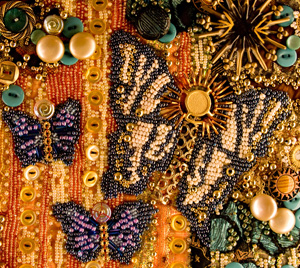 Of course, there’s always the option of beading a butterfly by hand, which I have done before. These three butterflies were hand beaded onto butterfly motifs cut from fabric. The largest in this shot, is about 3.5″ or 8.75 cm wide. With a large round button for the head, bugle beads radiate out to give a sunburst effect. Glass rondelles were used for the heads of the two smaller purple butterflies. Those have spacers from necklace strands for their bodies, while the larger butterfly has two links from an old bracelet for its body. All three have a great deal of details on them, which make for lots of impact in the composition. However, each of the smaller ones took about 2 hours to bead, compared to an hour to stitch down the Monarch iron-on with all of its beads, and the Monarch is more than twice the size of these smaller purple examples.
Of course, there’s always the option of beading a butterfly by hand, which I have done before. These three butterflies were hand beaded onto butterfly motifs cut from fabric. The largest in this shot, is about 3.5″ or 8.75 cm wide. With a large round button for the head, bugle beads radiate out to give a sunburst effect. Glass rondelles were used for the heads of the two smaller purple butterflies. Those have spacers from necklace strands for their bodies, while the larger butterfly has two links from an old bracelet for its body. All three have a great deal of details on them, which make for lots of impact in the composition. However, each of the smaller ones took about 2 hours to bead, compared to an hour to stitch down the Monarch iron-on with all of its beads, and the Monarch is more than twice the size of these smaller purple examples.
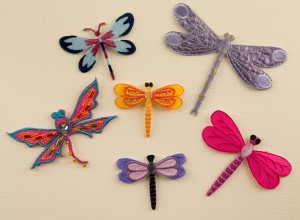 Finally, here are some iron-on dragon fly appliques waiting to find the right art quilt to decorate its surface. In nature, dragonflies are the dive bombers of the insect world, as they flit across the surfaces of water. They don’t have as large of a wing span, so they don’t make as much impact in an art quilt, but sometimes,it’s great to have more subtle details for a viewer to find upon close observation of the surface. I’d like to think as a viewer gets closer and closer to one of my pieces, that there would be more and more interesting details to see. Here’s where dragonfly appliques can serve their purpose in a garden scene. While fewer beads can be used, in order not to cover up the insect entirely, there is usually room for some of the larger size 6 and 3 seed beads on the outer edges of the wings.
Finally, here are some iron-on dragon fly appliques waiting to find the right art quilt to decorate its surface. In nature, dragonflies are the dive bombers of the insect world, as they flit across the surfaces of water. They don’t have as large of a wing span, so they don’t make as much impact in an art quilt, but sometimes,it’s great to have more subtle details for a viewer to find upon close observation of the surface. I’d like to think as a viewer gets closer and closer to one of my pieces, that there would be more and more interesting details to see. Here’s where dragonfly appliques can serve their purpose in a garden scene. While fewer beads can be used, in order not to cover up the insect entirely, there is usually room for some of the larger size 6 and 3 seed beads on the outer edges of the wings.
Using a pre-formed applique can free up your time to add other embellishments. Also, I like to use at least five of the same element when I can, so these butterflies and dragonflies can give more instant gratification to the creation of s surface design than beading them by all by hand. Considering that some of my larger art quilts can take 4 months to complete, I’ll take what time saving available to me if I’m not sacrificing the visual appeal of the work.
How do you feel about using commercially made embellishments in your work? Where do you draw the line as to what you’ll include?
Why not leave a comment as to your thoughts on this posting. Please take a minute, fill out the form below or by clicking on the “comments/no comments link” at the top of the posting, and then share your ideas with the rest of us. We all grow when we share our thoughts and impressions, so why not join our growing community of those who appreciate art quilts and textile arts. We’d love to hear from you!… and PLEASE tell like minded souls about this blog! The more readers and contributors, the more I write because encouragement helps the words flow!
You can see more of my art work on my web site at www.fiberfantasies.com (be patient as it loads; it’s worth it), my spiritual healing work at www.transitionportals.com and can find me on Google + , Facebook (for Transition Portals) Facebook (for Fiber Fantasies), and Twitter.
To find out how to buy my art work, please check out “How to Buy my Art Work” in the “Pages” section to the right of this blog.

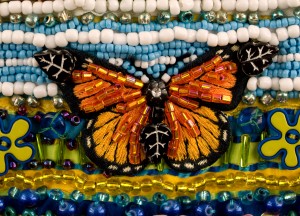


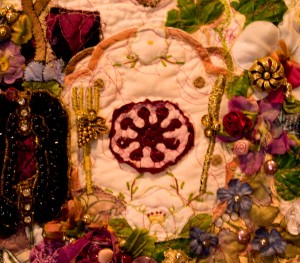
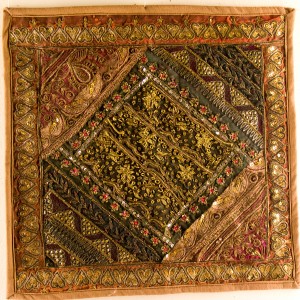
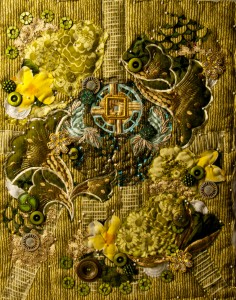
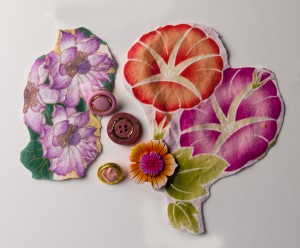

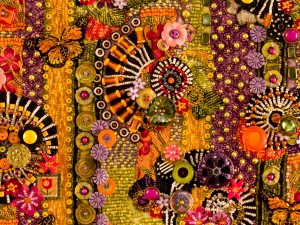
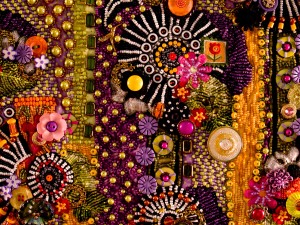
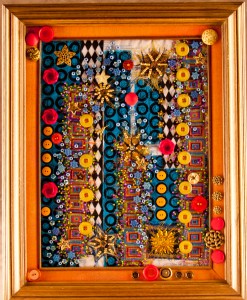
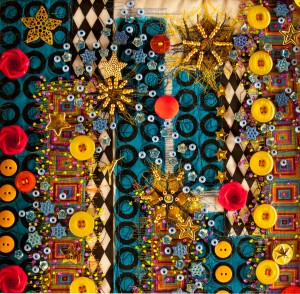
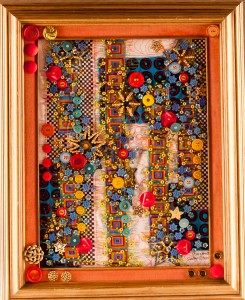 In this second piece, “Stars and Bars 2”, I used the same “bar” ribbon but a different black and white ribbon. In this full view, you can a little more of the free motion, horizontal stitches in the white areas near the top of the photo. To accomplish this free motion ability, you need to drop the feed dogs, and use a darning foot so you can move the fabric easily to where you want. With some practice, I got the tensions between the upper and lower threads in the bottom even, so that there were no big wads of thread either on the front or back. I was a little less obsessive with the buttons and beads, so there is more of the machine stitching visible. I remembered to use a 40 weight machine embroidery thread on this piece. While thicker in nature, so the stitching makes a bigger statement, that type of thread is not strong enough to take the push and pull of seams in clothing.
In this second piece, “Stars and Bars 2”, I used the same “bar” ribbon but a different black and white ribbon. In this full view, you can a little more of the free motion, horizontal stitches in the white areas near the top of the photo. To accomplish this free motion ability, you need to drop the feed dogs, and use a darning foot so you can move the fabric easily to where you want. With some practice, I got the tensions between the upper and lower threads in the bottom even, so that there were no big wads of thread either on the front or back. I was a little less obsessive with the buttons and beads, so there is more of the machine stitching visible. I remembered to use a 40 weight machine embroidery thread on this piece. While thicker in nature, so the stitching makes a bigger statement, that type of thread is not strong enough to take the push and pull of seams in clothing.